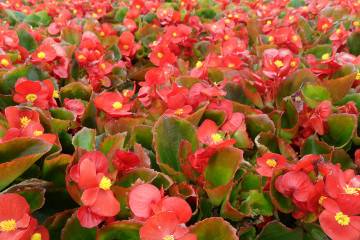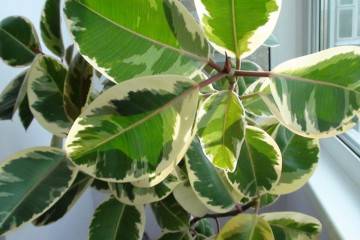Suitable land for Ficus - how to choose
Content:
When purchasing one or another flower, everyone relies mainly on its appearance. Few people think about the features and nuances of growing at home. Many indoor plant lovers are amazed by its beauty ficus. Its large, bright green leaves will adorn any interior. However, in order to preserve this beauty for a long time, careful care is required. Ficus soil is very important.
What kind of soil does ficus like?
Ficuses are not picky plants. However, to see a lush plant with dense greenery and beautiful flowers, you need to take care of the right soil for the ficus.
Essential ingredients and minerals
The soil for ficus should be low acid or neutral. pH should be in the range of 6.5-7 units. It is very important to periodically fertilize the earth and enrich it with minerals. The main components are sulfur, phosphorus, calcium, iron, potassium and nitrogen. They are applied periodically as fertilizer.
What are all soil elements for?
If the substrate is not saturated with all trace elements, the ficus may not grow at all, even with proper care. Sulfur, copper and iron are necessary for the emergence of new leaves and shoots, and nitrogen, potassium and phosphorus are responsible for the health of old and large leaves. With a lack of them, large and green shoots can be covered with small yellow dots.
How to choose the land for ficus
The next important characteristic is the constituents of the soil. Many people mistakenly believe that you can cover ordinary soil and the flower will grow. However, it is not. It is necessary to consider in more detail what kind of land is needed for the ficus.
What soils exist
You can prepare the soil yourself or purchase it from a flower shop. The choice of the option falls on the shoulders of the grower. Giving preference to purchased soil, it is necessary to carefully study its composition. If the composition indicates a low content of potassium and phosphorus, then you need to immediately apply top dressing. You must be careful not to oversaturate the ficus. In the worst case, this can lead to root burns. Peat soil quickly dries up and depletes its reserves of minerals and trace elements. When choosing such a land, one should prepare for frequent soil changes.
Soil for ficus with a high humus content requires constant loosening. Having caked and crumpled, it literally becomes a breeding ground for pathogens and pests.
There is also a landless medium, but it is only meant to transport the flower. It consists of peat, coconut fiber, vermiculite, sand and charcoal.
Experienced growers recommend 2 soil mixtures: "Ficus" and "Palma". They have established themselves in the flower market as the highest quality and safest.
Preparation of soil constituents for ficus
Young flowers need loose soil, into which air can easily penetrate, and water does not linger. For adults, a slightly denser soil is needed. So which soil is suitable for ficus?
Standard components:
- leafy land;
- peat;
- turf.
All components are mixed in equal proportions.
For an adult ficus, a denser soil is required. There are several variations of soil mixtures:
- turf, leaf earth and sand in a ratio of 2: 2: 1;
- turf, leafy soil, sand, peat soil in proportions 1: 1: 1: 1. Such a soil is suitable for Benjamin ficus;
- peat, humus and leafy soil for ficus in a ratio of 1: 1: 2.
Proper sterilization of the earth
The land can be cultivated in 3 ways:
- mechanical;
- thermal;
- chemical.
Each method needs to be considered in more detail:
- Mechanical soil cultivation consists in cleaning it from foreign impurities, stones and twigs;
- Heat treatment is steaming or freezing. This method contributes to the destruction of pathogens and pests;
You can steam the earth in the oven, microwave, but in a water bath, pour boiling water over it, followed by drying.
Freezing involves keeping the soil at a low temperature for a long time. However, it is important to note that this method will not rid the land of weeds and microorganisms.
Heat treatment kills all microorganisms, including beneficial ones. The earth restores its natural properties for a very long time. For the "revitalization" of the earth, it is recommended to introduce special biological products.
The earth is laid out on the surface and watered with a solution of potassium permanganate or pesticide. Intending to cultivate the land with a specialized solution with antagonist microbes, it should be borne in mind that not all pathogenic microorganisms will be destroyed. The use of biologics is more natural.
Major mistakes in preparation
Sometimes, in pursuit of lush flowering and the earliest possible adaptation of the ficus to a new pot and soil, the hands of an amateur grower are drawn to water, fertilizers and all kinds of top dressing. However, such actions can only cause a burn of the root system from an abundance of fertilizers. In order for the ficus to get used to its new place as quickly as possible, it is recommended to leave it alone for 1-2 weeks. During this period, it is necessary to adhere to moderate watering. The first feeding is done 1-1.5 months after planting.
Planting process
Ficus is transplanted by the transshipment method. If you buy a small plant, then in a year you will need to increase the pot and, accordingly, the volume of land.
An annual transplant is required up to 3 years of age. Then the flower is transplanted once every 3 years until it is 5 years old. An older plant is transplanted once every 6 years. The best option for a pot is 2-3 cm wider than the roots of the plant.
It is necessary to remove the old soil as much as possible. Put a drainage layer on the bottom, then place the flower itself. Lastly, fill the void in the pot. As the procedure is completed, the flower is watered abundantly. During the first month, the soil is simply sprayed regularly. It is recommended to resume watering no earlier than in a month.
What to do with the old land?
After transplanting plants, many are wondering what to do with the old soil. Some just throw it away, others use it for seedlings and in the garden, and still others restore and reuse it.
First, it should be remembered that the earth after the flower is depleted. During the entire period of growth, ficuses take useful micro- and macroelements from it. After 2-3 years of life in it, she loses her fertility. In addition, harmful bacteria and insects can start in it. Before planting seedlings, it is recommended to sterilize the soil and fertilize with a mineral complex.If a florist decides to use this land in a garden plot, then to restore its strength and fertility, it will be enough to mix it with the total mass of the earth and also fertilize it.
Adherents of the third method put the earth in a bag and add biological products to it for cleaning and sterilization, and then feed it with a mineral complex. So, after a couple of months, this land can be used for other indoor plants and not be afraid of the possibility of disease or wilting.
Every houseplant requires good, gentle and competent care. And it, as you know, begins with the choice of soil. Each flower will require an individual approach. Having chosen the best option, it will turn out to enjoy the bright and beautiful large leaves of ficus for a long time.




















